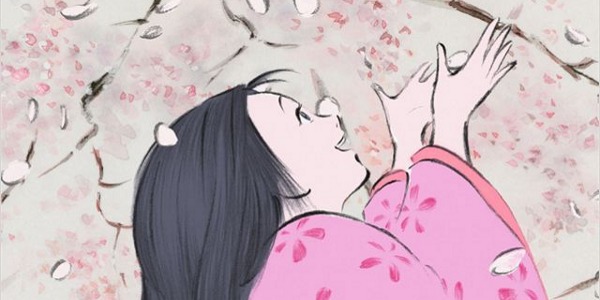The Tale of the Princess Kaguya tells the folklore of a Japanese princess born from a bamboo stalk in the heavens and raised as the child of an elderly agrarian couple. She lives and grows up rapidly right before our eyes, just like the bamboo from which she was bred. She was meant to live a more “normal” life, though, and is soon thrust into a lifestyle that contradicts her humble upbringings.
Thus begins a battle between tradition and the unorthodox, and the elegant story of a princess caught in between, as she comes to miss her motley group of friends, the freedom of the outdoors, and the beauty that exists only in the unhindered nature that she once inhabited.
A “Moving Painting”
The Tale of the Princess Kaguya is absolutely breathtaking. The film is meticulously crafted with an art style that brings with it a nostalgic air, like that of a storybook or an ancient painting. With tame watercolor and detail, the film captures a suitable whimsy and an exquisite allure. With subtle and limited brushstrokes and color, it impossibly captures so many complex emotions and details – a twinkle of joy in a father’s eye, the frittering of birds on a branch. It is frugal with details, and shows nothing that isn’t important in conveying its meaning.

It is easy to imagine the amount of heart and passion that went into hand-drawing each frame. Similarly, a soundtrack filled with minimalist twangs of traditional instruments intermingled with somewhat hectic noise grants a tender background sound that accentuates the free-spirited beauty of the rural community that Kaguya first lives in, at least before she is forced to live a more traditional life.
A Clash Between Cultures
And yet, despite its composition of mere strokes of a brush on a canvas, the film still evokes a wide array of emotions – one that is felt much more substantially than its American counterparts at Pixar or Dreamworks, whose scripts seem to utilize a tear-jerking formula more than anything else. It lacks the sense of bluntness that loses its appeal when clashed with older, more cynical minds, the type that afflict the more mainstream animated movies that fill theaters. Similar to director Isao Takahata‘s other masterwork, Grave of the Fireflies, we witness life in its wholesomeness, rather than witnessing large events that are part of a coherently structured narrative; and we are better able to identify and sympathize with the film because of it.
In The Tale of the Princess Kaguya, we witness a little girl growing up, becoming the rebellious yet grounded noblewoman she is born to be, and we follow her – through her joys, her sorrows, and her heartbreak. We hear a language foreign to our ears and see an artistic style and a directorial vision that we have not been able to experience before, one that is completely strange and unprecedented. Yet, we still find that it touches us with an intimacy that reflects the story successfully. By the end of it, we are left accustomed to the culture, customs, and time period that surrounds the film, and are left yearning for more.
Minimalistic Art; Indulgent Script
But still, The Tale of Princess Kaguya, in spite of all of its acclaim, does harbor some issues. Every character seems to talk with a similar slow and exaggerated inflection, bestowing upon the film a pacing that seems to drag for almost too long. Emotion seems almost over-emphasized, employing a cheap and overt redundancy of the same noises; the constant giggling unnecessarily exemplifies a happiness that is already shown through the visuals. These issues, however, are more culturally derivative than anything else, and can surely be found in most exemplary tales of anime. They are still a bit polarizing, though, at least to those not yet adjusted to its craft.
Conclusion
It was a surprise that The Tale of the Princess Kaguya went on to be bestowed a nomination for the Best Animated Feature at the Oscar’s, but it is a justified nomination at that. It is an amazing work of art, one that creates almost unimaginable sentiments within the heart that resonates throughout the film’s slightly lengthy run time. It has an immense power to enthrall, a captivating story, and a visual allure that will make the entire visit seem worthwhile.
The Tale of the Princess Kaguya is part of an elusive selection of films – an anime movie nominated for an Oscar. What film did you think should have won the Best Animated Picture award? What did you think of The Tale of the Princess Kaguya?
(top image source: Tojo)
https://www.youtube.com/watch?v=tM6hcHp0_kU
Does content like this matter to you?
Become a Member and support film journalism. Unlock access to all of Film Inquiry`s great articles. Join a community of like-minded readers who are passionate about cinema - get access to our private members Network, give back to independent filmmakers, and more.